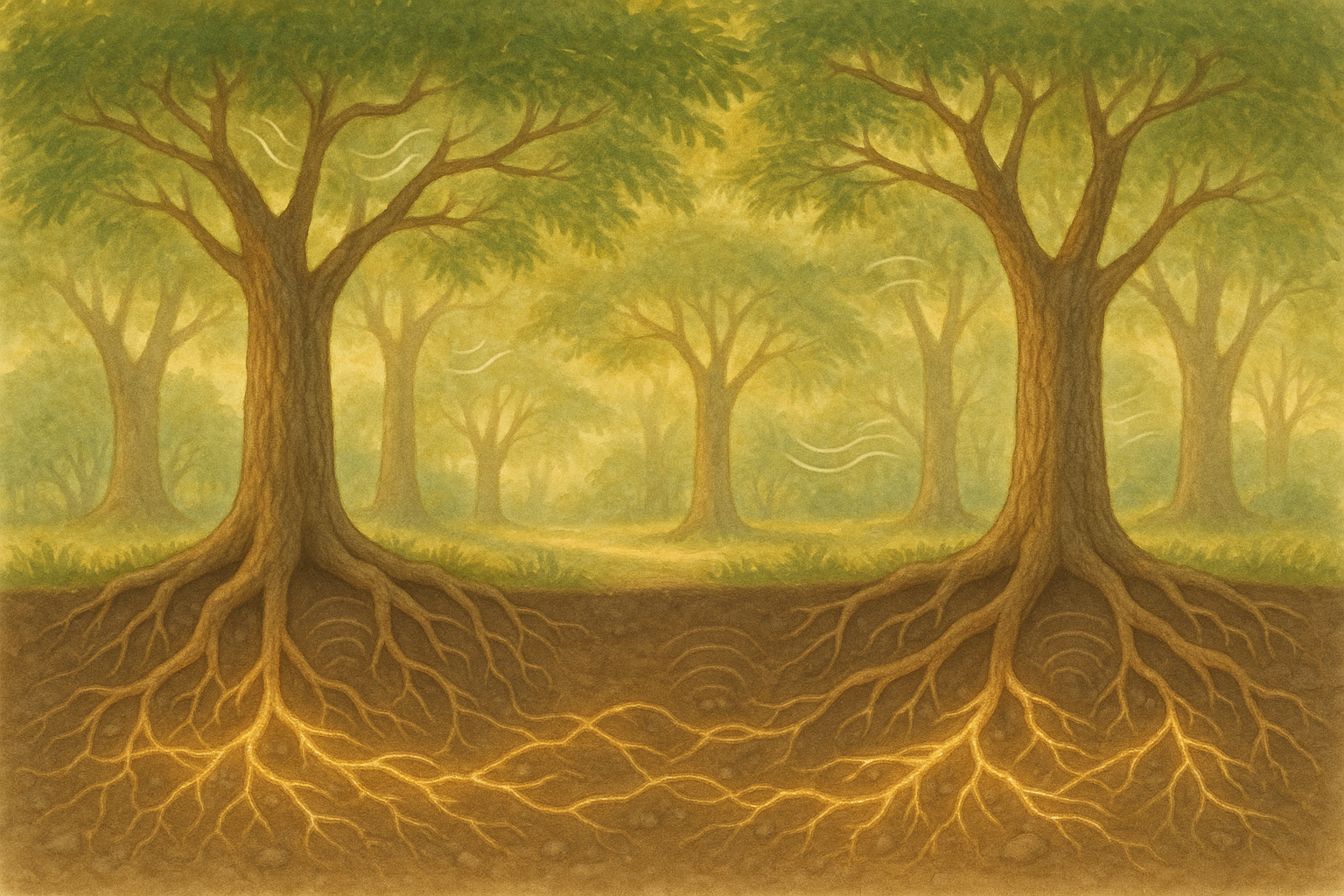
Root Communication
When Trees Talk: Exploring How Trees Communicate Through Sound, Scent, and Silence
If you sit long enough in the presence of a tree, you might start to wonder if it’s listening. Or maybe whispering. Maybe both.
At first glance, trees seem quiet. Still. Stoic. Their branches sway, their leaves flutter, their bark peels in patches, but they don’t make noise the way people do. They don’t howl or hum. They don’t send text messages or flash warning signs.
But make no mistake, trees are in conversation.
Their language isn’t loud. It isn’t written. It isn’t easy for us to notice. But it’s there, unfolding all around us in vibrations, chemistry, and touch. It flows beneath our feet and drifts in the wind. If you listen with more than your ears, you might begin to understand.
Some trees speak with scent.
When an acacia tree in Africa is nibbled by a giraffe, it doesn’t just sit back and accept its fate. Within moments, the tree releases ethylene gas into the air. Nearby acacias pick up the signal and begin pumping bitter chemicals into their leaves to warn off hungry grazers. It’s a message broadcast on a breeze. A way of saying: danger is here. Prepare yourselves.
Pines, oaks, and maples do something similar. When insects attack their bark or leaves, these trees emit scents that attract predators to eat the invaders. It’s a kind of forest version of calling for backup. Not a scream, but a chemical invitation.
Other messages travel beneath the surface.
Just below the soil lies a sprawling web of connection, where tree roots and fungal threads form a vast underground network often called the “Wood Wide Web.” Through this mycorrhizal network, trees share water, nutrients, and chemical signals. A mother tree can send sugar to her saplings. An old oak can warn others of drought. A sick tree might pass on its resources before fading away.
These exchanges are not random. They are relational. They are intentional. They reveal a kind of care, or at least a coordination that echoes something like community.
It’s not just scent or soil. Sometimes, trees talk through sound.
Not sound like chirping birds or rustling wind, but vibrations, tiny pulses that move through the air or earth. Scientists have recorded roots making subtle clicking noises as they grow. These clicks seem to help roots sense their environment, maybe even communicate with each other underground.
There are trees that respond to vibration, too. Poplars, for example, seem to strengthen themselves in response to soundwaves that mimic insect chewing. It’s as if they can hear trouble coming and brace themselves.
Even without ears, even without mouths, trees are aware of their world in ways we are only beginning to understand.
And then, there is the communication that isn’t so easy to explain.
The way two trees, grown side by side for decades, bend toward each other like old friends leaning in. The way a beech seems to shiver before a storm has even arrived. The way forests respond together to fire, regrowth, and age, as if guided by a silent choreography.
In winter, deciduous trees don’t just lose their leaves, they slow their entire being. Their roots rest. Their sap thickens. It’s a pause, a breath, a waiting. That stillness speaks too.
Some of the tree’s most powerful messages are written not in sound or scent, but in the shape of their limbs, in the texture of their bark, in the scars they carry. A lightning strike recorded in a split trunk. A long crack sealed over decades. A missing branch where an animal once made its home.
Each tree is a history book with no words and no page numbers, but every mark matters.
And still, they are generous. Even if we don’t speak their language, they keep talking.
They offer shade when we are hot. Shelter when we are tired. Oxygen without asking. Their quiet presence slows our racing minds. We walk through groves and feel calmer, without fully knowing why.
Maybe their silence speaks to something ancient in us. A reminder that life doesn’t always need volume to be heard. That communication can be gentle, and still powerful.
We often think of talking as something loud and obvious. But trees remind us that conversation can happen in stillness. That listening is more than hearing. That messages can travel on winds, in water, in the patient spiral of a ring of growth.
Next time you pass beneath a tree, try this. Pause. Close your eyes. Listen.
The branches might creak. The leaves might shiver. The bark might warm in the sun.
Maybe you won’t hear anything at all. But something is happening. A signal sent, a root extended, a scent released.
You may not understand what’s being said. But you’ve been spoken to.
And sometimes, that’s enough.
Did You Know?
![]()
Trees release chemical distress signals when under attack, warning their neighbors to prepare.
FAQs About Talking Trees
Do trees really talk to each other?
In their own way, yes. Trees use chemical, electrical, and even physical signals to share information about threats, resources, and growth.
What is the “Wood Wide Web”?
It’s a nickname for the underground network of fungi and roots that connect trees across a forest, allowing them to exchange water, nutrients, and signals.
Can trees hear us?
They don’t have ears, but they can detect vibration. Some studies suggest they respond to certain frequencies, especially those that mimic natural threats.
Why do trees release scents?
Scents can warn nearby trees of herbivores or attract helpful predators that will eat invading insects.
Have questions about the trees in your own yard?
Tip Top Arborists is here to help you care for your living legends. Let our certified arborists provide expert guidance for a lifetime of healthy trees.
